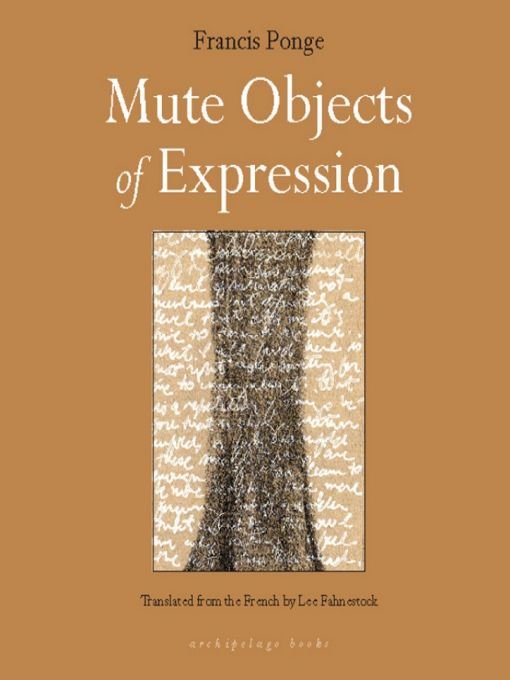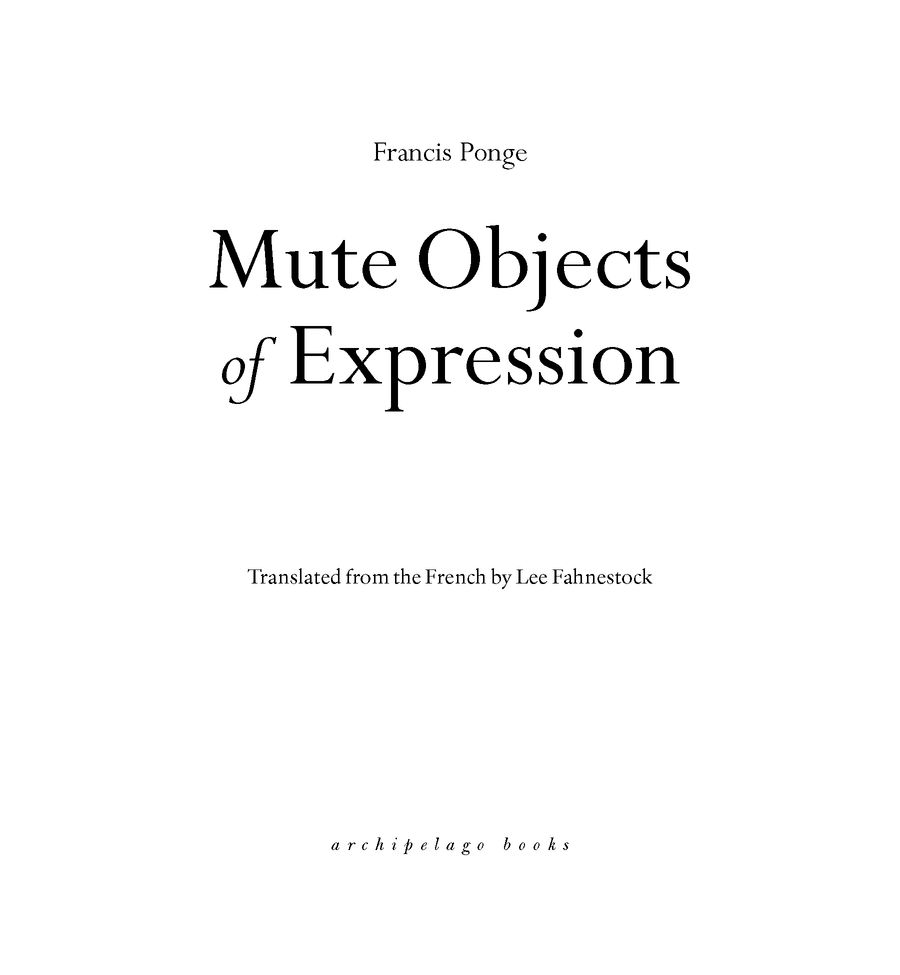Mute Objects of Expression
Read Mute Objects of Expression Online
Authors: Francis Ponge



Table of Contents
Â
Â
Â
Â
Â
Â
Â
Â
Â

BANKS OF THE LOIRE
Â
Â
Roanne, May 24, 1941
Â
From now on, may nothing ever cause me to go back on my resolve: never sacrifice the object of my study in order to enhance some verbal turn discovered on the subject, nor piece together any such discoveries in a poem.
Always go back to the object itself, to its raw quality, its
difference:
particularly its difference from what I've (just then) written about it.
difference:
particularly its difference from what I've (just then) written about it.
May my work be one of continual rectification of expression on behalf of the raw object (with no
a priori
concern about the form of that expression).
a priori
concern about the form of that expression).
Therefore, writing
about
the Loire from a place along the banks of the river, I must constantly immerse my eyes and mind in it. Any time they dry up over an expression, dip them back into the waters of the river.
about
the Loire from a place along the banks of the river, I must constantly immerse my eyes and mind in it. Any time they dry up over an expression, dip them back into the waters of the river.
Recognize the greater right of the object, its inalienable right, in relation to any poem . . . No poem ever being free from absolute judgment
a minima
on the part of the poem's object, nor from accusation of counterfeit.
a minima
on the part of the poem's object, nor from accusation of counterfeit.
The object is always more important, more interesting, more capable (full of rights): it has no duty whatsoever toward me, it is I who am obliged to it.
What the preceding lines do not adequately emphasize:
consequently,
never leave off at the
poetic
form â though it must be used at some point in my study because it produces a play of mirrors that can reveal certain persistently obscure aspects of the object. The reciprocal clash of words, the verbal analogies are
one
of the means for studying the object in depth.
consequently,
never leave off at the
poetic
form â though it must be used at some point in my study because it produces a play of mirrors that can reveal certain persistently obscure aspects of the object. The reciprocal clash of words, the verbal analogies are
one
of the means for studying the object in depth.
Never try to
arrange things
. Objects and poems are irreconcilable.
arrange things
. Objects and poems are irreconcilable.
The point is knowing whether you wish to make a poem or comprehend an object (in the hope that the mind wins out, comes up with something new on the subject). It is the second phase of this alternative that my taste (a violent taste for things, and for advances of the mind) leads me to choose without hesitation.
So my resolve has been reached . . .
After that I hardly care whether someone chooses to call the outcome a poem. As for me, the slightest hint of poetic droning simply reminds me that I'm slipping back onto the old merry-go-round and need to thrust my way off.
THE WASP
For Jean-Paul Sartre
and Simone de Beauvoir
and Simone de Beauvoir
Â
Â
A
Hymenopteran
of agile flight, feline â tiger-striped in appearance, actually â with body mass far exceeding that of the mosquito, yet with wings relatively smaller but vibrant and undoubtedly geared way down, the wasp vibrates non-stop at a velocity required of a fly under hypercritical circumstances (to come unstuck from honey or fly-paper, for instance).
Hymenopteran
of agile flight, feline â tiger-striped in appearance, actually â with body mass far exceeding that of the mosquito, yet with wings relatively smaller but vibrant and undoubtedly geared way down, the wasp vibrates non-stop at a velocity required of a fly under hypercritical circumstances (to come unstuck from honey or fly-paper, for instance).
She seems to exist in a perpetual state of crisis, which renders her dangerous. A sort of frenzy or folly â that makes for a brilliance as resonant and musical as a very taut cord, fiercely vibrating and therefore burning or stinging, rendering any contact dangerous.
She pumps away with fervor and thrusting hips. Deep into the purple or green plums, it's quite a sight: truly a small extirpating apparatus particularly, pointedly, well-done. Therefore it's not the generating point of the golden ray that is ripening, but rather the generating point of the ray (tinged gold and umber) that carries off results of the ripening.
Honeyed, sun-soaked; transporter of honey, sugar, syrup; hypocrite
and hydromelic. The wasp on the rim of a plate or half-rinsed cup (or jam jar): an irresistible attraction. Such tenacity in this desire! How they are made for one another! A veritable magnetic attraction to sugar.
and hydromelic. The wasp on the rim of a plate or half-rinsed cup (or jam jar): an irresistible attraction. Such tenacity in this desire! How they are made for one another! A veritable magnetic attraction to sugar.

Analogy between a wasp and an electric streetcar. Something mute in repose and vocal in action. Also something of a short train, with first and second classes, or rather the engine and the observation car. And of a sizzling trolley. Sizzling like a deep fry, like an (effervescent) chemical reaction.
And if she touches down, she stings! Nothing like a mechanical blow: it's an electrical jolt, a venomous vibration.
But her body is more yielding â that's to say more delicately articulated, all in all â her flight more capricious, unforeseen, more dangerous than the rectilinear motion of streetcars determined by the tracks.

A little itinerant siphon, a little distillery on wheels and wings, like the ones that go about from farm to farm through the countryside in certain seasons; a little airborne kitchen, a little public sanitation truck: all in all, the wasp resembles vehicles that are self-fueling and churn out a product along the way, which contributes to
the fact that the mere sight of them assures an element of wonder, for their essential purpose is not simply to move about or to provide transport, but also to carry out an intimate activity that's generally quite mysterious. Quite astute. What we call having an inner life.
the fact that the mere sight of them assures an element of wonder, for their essential purpose is not simply to move about or to provide transport, but also to carry out an intimate activity that's generally quite mysterious. Quite astute. What we call having an inner life.
. . . An airborne cauldron for making jam, hermetically sealed but yielding, the ponderous rear axle careening along in flight.

In order to classify the various species, it had obviously been necessary to take hold somewhere, at some part or member and, what's more, at a place attached solidly enough to the whole so it wouldn't come away when grasped, or else in the event that it did come off, would suffice in itself for recognition. Thus, for insects the wing was chosen. Perhaps with good reason: I have no idea, I certainly wouldn't swear by it.
Hymenoptera,
in any event, for wasps, isn't half bad. Not because a young girl's hymen, to tell the truth, bears much resemblance to the wing of a wasp, but apparently for other reasons. Here we have an abstract word that derives its concrete qualities from a dead language. Well then, to the extent that abstraction is a concrete thing, naturalized and diaphanized, both delicate and taut, pretentious, grandiloquent â this rather suits a wasp wing . . .
in any event, for wasps, isn't half bad. Not because a young girl's hymen, to tell the truth, bears much resemblance to the wing of a wasp, but apparently for other reasons. Here we have an abstract word that derives its concrete qualities from a dead language. Well then, to the extent that abstraction is a concrete thing, naturalized and diaphanized, both delicate and taut, pretentious, grandiloquent â this rather suits a wasp wing . . .
. . . But I won't go on much further in this particular direction.

What is it they say? That the wasp leaves her stinger in the victim, and dies in the process? That would be a pretty good emblem for fruitless warfare.
So she had generally better avoid all contact. And yet, when contact does occur, inherent justice is satisfied: by the punishment of both parties. Still, the punishment seems most severe for the wasp, who inevitably dies. Why? Because she made the mistake of considering the contact hostile and instantly flared up in defensive anger, because she struck. Betraying an exaggerated sensibility (out of fear, of excessive sensitivity, most likely . . . but due to extenuating circumstances, alas! â it's already too late.) So it's quite evident, let us repeat, that the wasp has nothing to gain by engaging an adversary, that she should rather avoid all contact, make any detours and zig-zags necessary to that end.
Other books
The People's Tycoon: Henry Ford and the American Century (Vintage) by Watts, Steven
Flip by Martyn Bedford
Double Deceit by Allison Lane
Young Mr. Obama by Edward McClelland
The Third Rail by Michael Harvey
Coming Apart (9780545356152) by Martin, Ann M.
You're My Baby by Laura Abbot
Running Like a Girl by Alexandra Heminsley
It Takes Two (Italian Summer Book 1) by Lily Zante
Laura Jo Phillips by Berta's Choice
